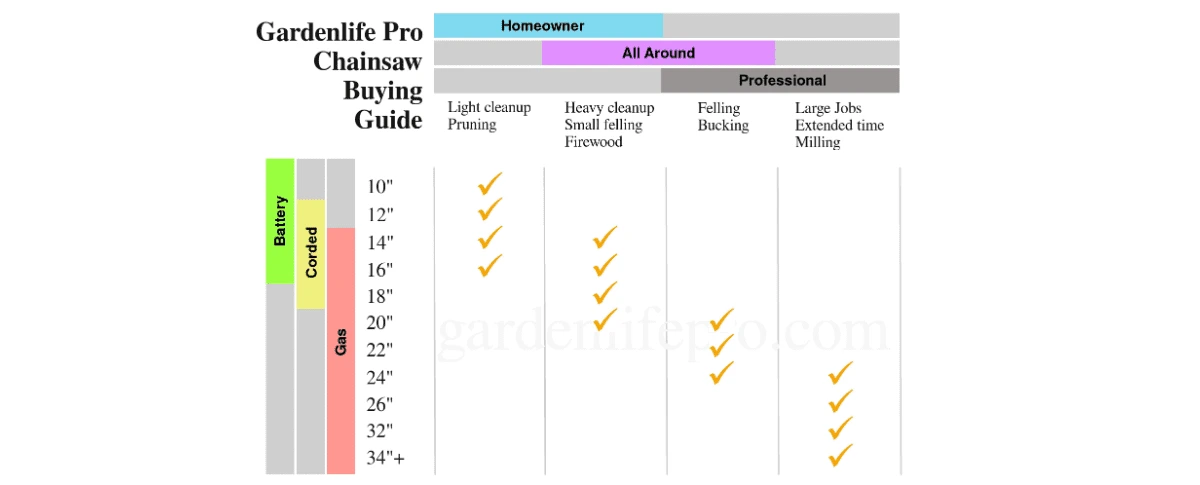Chain saws are very functional tools for various tasks in different environments. Traditionally, one would say they are best for cutting down trees, but actually, chainsaws are mostly used at regular homes for clearing yards of dead wood, cutting up fallen branches, harvesting and slicing firewood, not to mention chainsaw carving, ice sculpturing, and even milling!
There are lots of brands and models available on the market, so it is a cumbersome task to figure out which one is the best for you. Purchasing a chainsaw is a difficult process without prior experience.
People at first check into local hardware stores or browse the web looking for chainsaws and later turn to realize that they know little or nothing about what they are really looking for.
It is not straightforward and at the beginning difficult to decide what to look for in a chainsaw. We gathered the most important chainsaw features, types, safety best practices, and protective gears, as well as maintenance considerations so that you can make a more informed decision with this chainsaw buying guide.
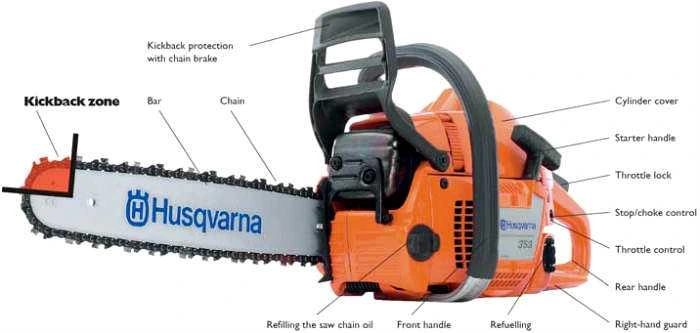
The 5 Minute Quick Chainsaw Buying Guide: Finding the Right Chainsaw
The most vital attributes to keep in mind when shopping for chainsaws are the following:
- Purpose and project requirements
- Chainsaw type
- Guide bar length
- Your experience and fitness level
- Budget
- Features
- Maintenance needs
Purpose and Project Requirements
The first step in your research for the best chainsaw for your own needs is to define what would be the purpose of buying a chainsaw in the first place, and what projects you want to use it for.
In case you are a homeowner and only need a chainsaw for an occasional clean-up and light cutting then an electric chainsaw would probably do the job. Is the power socket far away for some of the areas you need the job done? Then you should consider a battery powered chainsaw because for corded models there is a limitation on the length of the extension cord you can use.
As a homeowner, are you going to do felling and bucking? Or do more heavy tasks for an extended time? Then better get a traditional gas chain saw.
Are you working at a ranch or farm or need a chainsaw for regular use? Go for a gas chainsaw with a good size bar.
There is a pretty useful chart below where you can find the right type of chainsaw for the job.
Chainsaw Type
The main chainsaw types are gas, corded electric, and cordless / battery powered electric.
Gas powered chainsaws can be the most powerful, heavy, and in general, the ultimate choice for professionals. However, they do require lots of maintenance, gas, and oil, they produce fumes and tend to be heavy.
Corded electric chainsaws are much lighter and need no fuel, are easy to start, not to mention they are usually the cheapest of them all. But the extension cord can get in the way and also limits the working area and need to consider the distance from a power outlet.
Battery powered aka cordless chainsaws are usually powered by lithium ion batteries and of course, their run time is limited. Cordless chainsaws are also heavier than their corded counterparts.
You can read more, detailed descriptions and analysis of these main types of chainsaws in the next chapter with a few additional, unusual tools, such as pole saws and loppers.
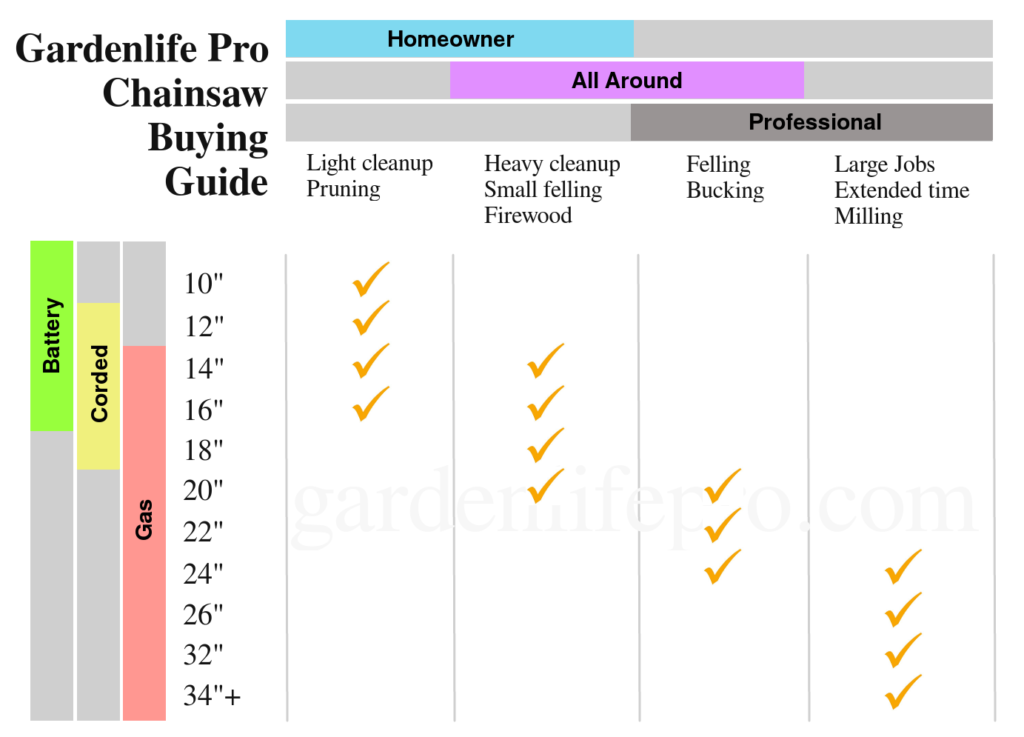
Guide Bar Length
The ultimate advice for beginners is to get the smallest chainsaw that still does the job.
The guide bar length is measured right from the end of the chain to where it fits into the chainsaw’s frame. It is a measurement, which depicts the aggregate cutting area and, basically, the size of the wood you can cut with a solitary pass. Size is a vital thing to consider when shopping for a new chainsaw.
For instance, suppose that you need to cut down a few trees easily. A chainsaw having a guide bar length of 20 inches, for example, can nearly cut through double its length in a solitary pass. We say “nearly” on the grounds that the guide bar ought to be two or three inches longer than the object you are attempting to cut.
Typical guide bar length sizes are as follows:
- 10 to 16-inch: light cleanup, pruning, trimming; ideal for beginners and homeowners
- 14-inch to 20-inch: heavy cleanup, felling of small to medium trees, light to medium duty firewood cutting;
- 20-inch to 24-inch: felling, log bucking, and heavy duty cutting
- 24-inch and up: Mostly professional use for large jobs and extended use time, also suitable for milling
Your Experience and Fitness Level
Your experience defines the type and size of chainsaws that you should get.
For beginners, an electric chainsaw with a guide bar length of less than 16 inches would be ideal, alternatively, a battery powered chainsaw, but these tend to be heavier and more expensive.
If you are a beginner but with some affinity to power tool maintenance and DIY, you could still consider gas saws, but then you have to factor in the extra maintenance needs and the chores of mixing fuel and oil, etc.
Average and experienced users shall freely choose the engine type and bar length to fit the job best, as their experience will not affect safety and other concerns.
In terms of your fitness level, you should keep in mind that the lightest chainsaws are the corded electric ones, while the battery and gas alternatives tend to be heavier. Longer jobs could easily take a hit on your back and arms, not to mention that big, heavy chainsaws are more difficult to control.
Budget for Chainsaws
In case you are on a budget, you should turn to electric, as corded chainsaws tend to be the cheapest on the market. You can pick up a good quality electric chainsaw from $70.
Cordless chainsaws and their gas powered alternatives are roughly in the same price range, where you have to fork out at least $200 to get a decent piece of tool. You can go ahead and check latest models and prices on Amazon.
Features
As it is the case for all gadgets and power tools, the features on offer often sell the product, but as a cautious buyer, you need to understand what are the most important features to look for when buying a chain saw.
Later on in this article, we have listed the most popular buzzwords and common features with descriptions. We hope this list can help your research and find your way around these technical terms.
Chainsaw Maintenance
The maintenance aspect of buying and owning a chainsaw is equally important.
There are common maintenance needs for all types of chainsaws, like lubricating the chain (called bar or chain oil), chainsaw chain sharpening, and others.
We are going to tell you a lot more about maintenance and best practices later in this article. But for now, the most important takeaway from this section is that if you are looking for the least demanding tool then go for an electric corded one.
A little bit of a step up in maintenance needs is a cordless chainsaw, where even the most modern lithium ion batteries need some care, but at least demand some attention to being fully charged before it is needed.
Traditional, gas chain saws are very demanding in operation and maintenance terms as well. Consider the requirement of two different kinds of oils, one for the general lubrication of the chain, and the other that the two stroke engine needs. You would also need to check and occasionally replace spark plugs, air, and fuel filters, and this list goes on. Assuming you are somewhat technical, these should not be too difficult but better get prepared.
Best Chainsaw Brands on the Market
Husqvarna
Husqvarna is a well-recognized brand name for lawn and power tools in American homes, but the brand is actually older than America itself. Founded in 1689 as a rifle manufacturer in Husqvarna, Sweden, the brand began branching out to design other products like sewing machines, bicycles, and lawnmowers, as well.
In 1959, Husqvarna launched the production of a chainsaw, and has remained a favorite ever since. In fact, Husqvarna name is more associated with forestry products – especially the chainsaw- more than it is with other lawn and garden products.
Every Husqvarna chainsaw manufactured since 1959 has featured its signature color of bright orange with black details. For sixty years, the manufacturer has consistently released upgraded designs and features that can tackle bigger forestry projects, allowing Husqvarna to remain at the top of the class for forestry professionals.
Some of Husqvarna’s noteworthy innovations include Low-Vib dampeners, TrioBrake, and air injection centrifugal air cleaning systems which all contribute to their chainsaw’s safety, comfort, and function.
Some of the most popular chainsaws by Husqvarna are the 455 Rancher for home use, the 536Li XP, and the 550 XP for forestry professionals.
Stihl
Perhaps the most famous orange chainsaw is manufactured by Stihl. If so, Stihl rightfully earned that accolade as the original best chainsaw brand. In 1926, Andreas Stihl engineered the very first chainsaw in Wehrmacht, Germany.
The original chainsaws were large and extremely heavy, often requiring two or more men to operate them. Stihl’s chainsaw was used heavily in WWI throughout Eastern Europe and Russia to cut timber for defensive positions.
In the 1960s Stihl chainsaws came to America where they were re-designed and marketed for household use. Chain breaks, electric ignition, automatic chain-oiling, and anti-vibration handles are all features that propelled Stihl to fame among American households.
While forestry equipment is at the core of Stihl’s product designs, they have branched out considerably to include other lawn maintenance tools.
Stihl remains one of the top chainsaw manufacturers for U.S. consumers, while also recognized as a popular manufacturer of other lawn and garden equipment such as augers, lawn mowers, tillers, and weed trimmers, among other tools.
Some unique chainsaw innovations from Stihl include the centrifugal clutch, comfort saw technology, chain braking system, and long life air filter system. These features generally make their chainsaws more safe, more functional, and more durable.
Some of Stihl’s most notable chainsaws include the Stihl MS 250 for home use and the Stihl MS 271 for loggers and forestry professionals.
Remington
Another famous name in power tools, Remington is one of the top chainsaw manufacturers in the country.
Founded in 1921 in Milwaukee, Wisconsin, Remington power tools became popular for hand-built, electric, and gasoline-powered drills and saws.
In 1954 it began manufacturing chainsaws for forestry professionals. Since then, it has continued expanding and refining the chainsaw design into practical products that everyone can use at home.
In the 1990’s Remington released their electric chainsaw and pole saw. Although most well-known for hand-held tools, Remington remains a major competitor in chainsaw manufacturing and sales to date.
In 2009, Remington was acquired by MTD Products, an American manufacturer based out of Valley City, Ohio which specializes in outdoor power equipment for the mass market. Some notable Remington innovations also include their technology for tool-free chain tensioning, the automatic chain oiler, and the mechanical chain break.
Some of the most notable Remington chainsaws include the RM4040, the RM 1425, and the RM4620.
DeWalt
DeWalt is best known for its bright yellow hand-held power tools such as drills, circular saws, and impact drivers, but they are a top manufacturer of chainsaws as well. The brand was founded 95 years ago by Raymond DeWalt after he invented the radial arm saw.
The company was founded in 1924 and in 1949 was bought by American Machine and Foundry Co., Inc. and then was sold to Black and Decker in 1960. To this day, DeWalt remains a subsidiary of Black & Decker, another popular chainsaw manufacturer.
Some of DeWalt’s products are assembled in America, but mostly use parts previously manufactured from other parts of the world like China, Brazil, the Czech Republic, Mexico, Italy, and the U.K. DeWalt is also famous for its representation in the NASCAR circuit, sponsoring drivers since 2011 with its famous yellow and black vehicle design.
Still, DeWalt remains one of the most recognizable names in the power tool industry with an impressive range of products including their five main product lines: the Dewalt 60V Max & 120V Max, 20V Max, 40V Max Outdoor Power Equipment, 8V MAX*-14.4V, and 18V cordless tools.
We have tested the DeWalt DCCS670X1 model extensively.
Poulan Pro
Poulan Pro is a newer manufacturer compared to some of its competition, but they remain a popular name in chainsaw production. In 1946, the Poulan Saw Co. was founded in Shreveport, Louisiana by a lumberjack named Claude Poulan.
The original chainsaws that Poulan designed were so heavy it took two or more men to operate them. Within 15 years, the Poulan brand was well-known among loggers and forestry professionals in the southern U.S.
During the 1960’s the chainsaw was redesigned and the chainsaw range was broadened to accommodate demand from the general public for chainsaws that could be used at home.
The company continued producing saws until 1970 when it also broadened its brand production to include lawn and garden equipment such as weed trimmers and lawn mowers. Today, they manufacture a variety of equipment that includes snow blowers, riding lawnmowers, and accessories. Their chainsaw innovations and developments include Oxypower, an electronic brake chain motor, and an advanced anti-vibration system.
Some of the most popular Poulan Pro chainsaws include the PPB4014, the PR5020, and the PP4218. These options sell well and receive good reviews for their cutting ability and durability.
Black + Decker
Perhaps the name Black + Decker is synonymous with power tools. Black + Decker began as a small machine shop owned by S. Duncan Black and Alonzo G. Decker in Baltimore, Maryland in 1910. They invented the hand-held electric drill in 1917. Since then, Black + Decker has acquired patents for different features of their drill and has grown to manufacture dozens of power tools including chainsaws.
Black + Decker remains one of the largest power tool manufacturers in the industry and acquired several other businesses including DeWalt and the General Electric Company.
Partnering with Stanley, Black + Decker has continued to thrive with over 1,000 product variations each year and pioneering over 40 completely new innovations. They generate over 11 billion dollars per year in revenue and employ over 27,000 people. The company is still based out of the U.S. in Maryland.
A few of their most notable chainsaws include the GK1000, the GKC360L20, and the LCS1240 cordless chainsaw. Even if not in terms of chainsaws, Black+Decker is definitely one of the best tool brands on the market today.
Tanaka
Tanaka chainsaws are manufactured by a company called Metabo HPT, formerly known as Hitachi Power Tools.
Specializing in multi-volt power tools, this company is headquartered in Tokyo, Japan. Tanaka is responsible for many innovations in the power tool manufacturing industry including the sliding compound miter saw, cordless impact driver, and metal stud cutter, among others.
In 1948, the company was founded as a coal mining machinery and electric power tool manufacturer. By 1957 it had produced over one million units of power tools, then began importing electric power tools to the U.S. in the 1970s.
Tanaka’s parent company, Metabo HPT, launched a multi volt platform in 2018 that allows their tools to operate either with a cord or cordless.
Greenworks
Greenworks is one of the newer power tool and chainsaw brands, but that does not mean that it is not already a trusted brand by many.
In 2007, Greenworks was founded to market lithium-ion technology and power tools for their parent company, globe tools.
In 2010 they released a line of electrical power tools. Greenworks may be best known for the lithium-ion technology in their products.
Stihl owns part of the Greenworks parent company which may also lend to the organization’s credibility and recognizability. Their headquarters is located in Mooresville, South Carolina.
Greenworks chainsaws come in a wide variety of styles and features and are one of the more cost-effective brands for non-forestry needs.
Makita
Makita is a power tool manufacturer based out of Japan. The company was founded over 100 years ago in 1915 and today has facilities in Brazil, China, Germany, Mexico, Thailand, Romania, the U.K., and the U.S.
In 1969, Makita released the first ever rechargeable drill and later, the first rechargeable drill.
Makita reports nearly 3 billion dollars in revenue and employs over 13,000 people. The wide variety of tools the Makita brand manufacture and markets today include chainsaws, lawnmowers, leaf blowers, weed trimmers, and hedge trimmers.
Other Things to Consider When Buying a Chainsaw
Safety
There is no doubt about it, chainsaws are really dangerous tools. When in the wrong or inexperienced hands, they can cause severe injuries or even death.
A study by the CPSC found that in 1999, there were over 28,500 reported chain-saw injuries in the U.S. By 2004, as the included chart shows, that number was up by over 32,000 (source).
In view of that, it’s crucial that you pick a chainsaw that best suits your expertise level and always wear protective gear. Of course, first thing first, follow the manufacturer’s instructions and read the manual for your chainsaw.
One particular cause for injuries is coming from kickback, a term used to describe when the tip of the guide chainsaw bar catches on wood or other objects without cutting it through. This throws the chainsaw upwards and toward the operator while the chain is still running.
Apparently, a chainsaw that has a long guide bar tends to cause more kickback than a chainsaw with a shorter guide bar. Hence our advice is to get the smallest chainsaw that fits your needs, no need for the unnecessary risk involved with huge, heavy chainsaws.
Evidence from the huge number of people sustaining injuries from chainsaws every year, there is no argument that chainsaws can be dangerous to operate, even for experts.
Weight
Another important aspect to consider is the weight of the chainsaw. Always use a smaller chainsaw for lighter tasks as weight and increased vibration can cause fatigue over long periods of use and sawing could end up plainly dangerous.
Ergonomics
Normally, anybody would want a chainsaw with great ease of use. You would want a chainsaw with a relatively lightweight, all-around adjusted for handle and weight placement, simple chain tightening, little vibration, and, maybe in particular, an easy and quick start.
Top handle vs Rear handle
The top handle chainsaw enables the user to control the operation and direction of the chainsaw unit right from the top. This specialized, professional chainsaw kind is essentially used for working on elevated platforms / in harnesses or on lying branches.
The rear handle chainsaw is made for average, on ground use and it’s good for beginners.
What to Do With Logs?
Using a felling axe will work on smaller logs, but it will require a lot of hard work to chop through a pile of rounds.
You can of course use a chainsaw following this guide but alternatively, you may want to consider an additional log splitter. A log splitter will save you time and a considerable amount of timber.
Chainsaw Types
Gas Powered Chainsaws
Gas powered saws are popular with both occasional and professional chainsaw users. As the name implies, gas-powered chainsaws run on gasoline (petrol). They have two cycle or two stroke engines that run efficiently on a mixture of oil and gasoline.
The oil greases up the internal part of the engine and averts excessive damage or wear while the gasoline is needed for combustion.
Read our Best Gas Chainsaw Reviews for 2022!
The 2-stroke engines provide the chainsaw with a higher power to weight ratio and therefore, the gas-powered chainsaw is very effective and powerful, cutting wood quicker than all other chainsaw types.
Be that as it may, gas-powered chainsaws are likewise heavier, produce more vibration and noise, and furthermore require regular servicing and refueling when contrasted with other chainsaw types.
Gas-Powered chainsaws are costlier when compared to corded electric saws and could be twice as expensive sometimes.
Pros
- Highly mobile. One can bring the saw almost anywhere
- More capable of handling heavy duty tasks
- Power. More torque and power than any other type
- Professional. Most men in the trade use primarily gas powered engine
Cons
- High maintenance. Regular looking after is required
- Pollution. Two stroke engines are imperfect combustion engines
- Noise levels can reach harmful decibel levels
- Weight
Corded Electric Chainsaws
Electric saws have a plug-in power cord and run on electricity. They don’t have gas engines that require fuel to run.
One thing about the corded electric chainsaws is that they are pretty immobile due to the fact that they have to be plugged-in to a power source. Although they can be easy to use in the event that there is a portable generator that could be mounted on a vehicle and then connected to the chainsaw via an extension cord.
Read our Best Electric Chainsaw Reviews for 2022!
In the absence of a portable generator, they can’t be used for big tasks like felling trees in the forest. Contrasted with gas-powered chainsaws, corded electric chainsaws have limited use and considerably less power. They are more suitable for small tasks and don’t need much power.
In any case, they are better performing than battery-powered chainsaws and can also be utilized for sawing small trees, limbs, and thick branches.
Unlike the gas-powered models, corded chain saws don’t produce deafening noise or as many vibrations, and due to their lighter weight, they can even be used by a less experienced person.
Electric chainsaws are also a good choice for a regular homeowner looking for something to do light chores with. Be that as it may, you will most likely need heavier, better quality extension cords to provide the amperage needed.
Their ultimate disadvantage is that they have to be plugged-in to a power source or utilized together with a portable generator and with that they pose a risk when used in the forest, as the cord could get tangled in the undergrowth and intensely lush zones. This makes them badly designed for use in forested areas.
Electric saws are significantly less expensive than gas-powered and battery-powered chainsaws, however, are more expensive than pole saws or manual chainsaws.
Pros
- Quiet. Tend to be much less noisy than gas powered saws
- Light
- Low maintenance
- Easy to start
- Better for health and environment due to no fumes emitted
- No need to mess around and mix fuel with oil
Cons
- Unsuitable for heavy duty tasks
- Mobility is limited by power cords and extensions
- Safety concerns in wet conditions
- Usually equipped with short to medium bars (up to 20 inches)
- Slower chain speed
Battery Powered Chainsaws
These chainsaws are also called cordless chainsaws. They use rechargeable batteries rather than fuel or mains electricity. The more modern batteries are lithium-ion that last longer and are easier to charge.
While being cordless and electric disposes of the requirement for regular engine servicing and fueling as with gas-powered chainsaws, it additionally implies that the batteries must always be charged in order to keep the unit running.
Read our Best Cordless Chainsaw Reviews for 2022!
Most times, this confines the amount of work that can be done in a single session. Cordless chainsaws are made for lighter tasks that may incorporate trimming, pruning, and felling small trees.
They are less powerful compared to corded electric saws but still perfect for light tasks that don’t take much time. Despite the fact that they create less power when contrasted with both gas-powered and corded chainsaws, battery-powered chainsaws are really the most expensive (price-to-performance wise) chainsaw models as far as the industry is concerned.
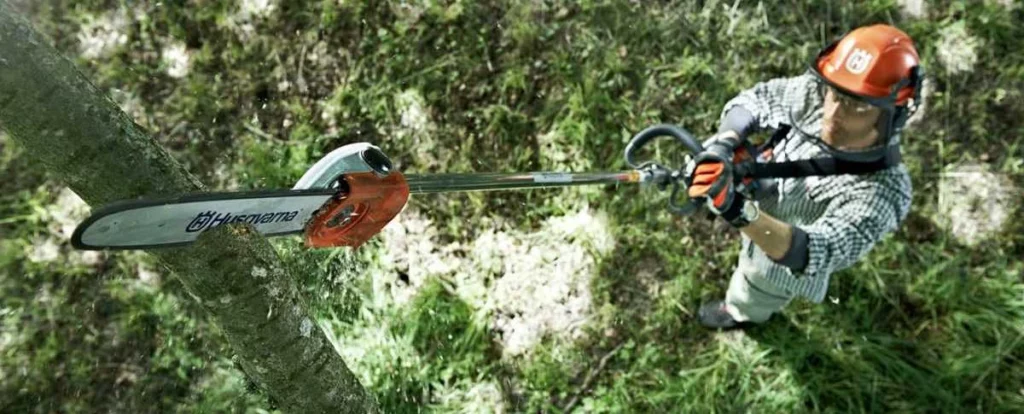
Pole Saws
A pole saw is simply a small saw fixed to an extension pole and essentially used to aid your reach cutting and trimming or eliminating small tree branches. Though this saw can’t be termed as a chainsaw, they are connected in a few aspects.. Pole saws can also be gasoline-powered, corded, or battery powered.
Read our Best Electric Pole Saw Reviews here!
Just like typical chainsaws, gasoline-powered pole saws are more powerful than their electric counterparts and are subsequently used to prune thicker trees and branches. They likewise produce a lot of noise and vibration.
Electric pole saws have reduced power capacity and are utilized for lighter tasks. Be that as it may, corded pole saws are more powerful than the battery-powered counterparts. Battery-powered pole saws are the most costly in this classification followed by gasoline-powered models and then corded pole saws are considered as cheapest.
Pros
- Extended reach
- Safer to work on dense tree crowns and with high branches
Cons
- Less power
Electric Loppers
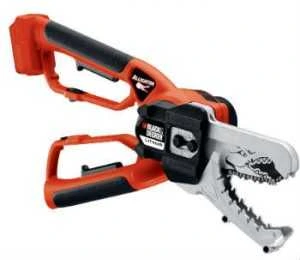
We all know standard loppers with handles and two jaws that we use to trim small branches. Imagine the same setup but with the power of a chain saw. There you go, this is the weirdest item in our guide, the electric loppers, a highly specialized cutting tool.
Electric loppers are heavy duty tools with cutting bars and chains. They can deliver fast cutting of small to medium branches that would be too big for manual scissors. These loppers are also known as jawsaws, describing their look rather well, with model names like “Alligator” and such.
Read our full Alligator Lopper Roundup Review!
Pros
- A safer alternative of a chainsaw for light cutting
- May cut branches up to 4 inches
- Cheaper than most chainsaws
- Low maintenance
Cons
- Being corded mobility is limited
- Highly specialized tool
Chainsaws for Milling
Have you considered milling with a chainsaw? The good thing is there is no need for a specialized chainsaw to mill logs into lumber that you can use for fences, furniture, shacks, or even houses.
Certainly, milling is considered a heavy duty task and as such, it is important to pick the right chainsaw for the job. A battery powered or light duty gas chainsaw that you would normally use for cutting firewood is not going to cut it. Better to go for a high performance, durable and robust chainsaw with a long bar.
A sole chainsaw of course will not be suitable for cutting usable lumber, the thing you need is called a chainsaw mill or Alaskan mill. These mills are a type of sawmill that usually consists of a pair of rails or guides that are attached to the chainsaw, with the intention to be adjustable for precise lumber cutting to the required thickness and size.
Manual Chainsaws
Manual chainsaws neither require electricity nor fuel to run. You may not find them readily available with the chainsaws suppliers and the majority of users make these manual chainsaws utilizing a saw chain and various easily accessible materials.
Basically, it’s more or less like using a chainsaw’s chain to cut wood; replacing the gasoline engine with your arms.
Some people adopt this method in cutting or trimming firewood in the event that they can’t bear the cost or for any reason, would prefer not to purchase a normal chainsaw. They don’t produce exhaust or noise, however, they can be tedious because they involve great effort.
As expected, manual chainsaws have a lesser power capacity compared to other types of chainsaws.
Notwithstanding, they are exceedingly portable and much faster than some other handheld saws. They are cheap since you are only buying the saw chain and a couple of accessories which may incorporate; a needle, nylon webbing, a hack saw waxed linen thread or nylon string and matches in order for it to be comfortable for use.
Commercially available manual or pocket chain saws can be found for around $20 or so that also include handles and a pouch.
Pros
- Extremely cheap
- No maintenance
- Easy to handle
Cons
- Can be tedious to operate
- Hard work to cut through thick branches
Top Features of a Modern Chainsaw
When shopping for chainsaws, you will come across a huge list of features that manufacturers use, often with their own terms, but essentially covering the same common feature under a different name. Hope you can use our list of definitions as a base for your further research.
We tried to collect the most common features here that make using a chainsaw easier, more comfortable, and safer.
Kickback reducing systems
The most effective action to prevent kickback is training. However, as a homeowner, especially if you are not very experienced, there are features and other solutions to look for to reduce the risk of injury, in the case eventually kickback occurs.
Manufacturers are trying to design chains that are less likely to cause kickbacks with protective links between the cutting teeth, while a well thought trough bar design with a special nose is also a risk reducing factor.
Some companies utilize kickback guards and automatic chain brakes in the event of a kickback, limiting the damage that a launching bar can deliver.
Anti-vibration system
Vibration in chainsaws is known to be a serious issue that will affect you when using your machine for a long period of time. Vibration is most evident in gas chainsaws and increases in line with the engine size. Anti-vibration systems help in reducing the burden and thus make sawing more comfortable.
An anti-vibration handle is essentially an isolator, that dampens vibration and therefore reduces fatigue and also extends the lifetime of the chainsaw.
Chain brake
What chain brake does is that it stops the chainsaw if there is a sudden movement, for example, kickback, lessening the risk of injury. The chain brake can be manually controlled by pushing the top hand guard forward and pulling back to release the break.
Automatic oiling
All kinds of chainsaws, even electric ones require proper chain lubrication. Some chainsaws have manual oiling features where the operator has to press a button from time to time.
Automatic oiling systems lubricate the chain as it is being used, with no need for manual activation. These systems make sure that the chain is lubricated at all times without wasting oil, offering safer operation, more efficient cutting, and extended lifetime for the chain.
Safety throttle or trigger
Most models accompany a safety trigger. This implies that when you turn on the chainsaw, the trigger must be grasped constantly. In the event that anything makes you release the trigger, the chainsaw automatically turns off and the chain will not be driven.
Chain catcher
In the event that the chain should break or get derailed, a catcher will guard you by ensuring it doesn’t fly loose and cause any injury.
Right-hand guard
All chainsaws are designed for right-handed use, with the right hand on the rear handle, and the left hand on the top handle. The right hand guard is a common feature that protects the user’s hand and fingers, should the chain break or derail.
Blade cover
It’s vital to always cover the blade when the chainsaw is not being used. This will avert any accidental wear, and in addition any injury.
Spring-assisted starting
Using the power of a metal string, this feature reduces the pulling force needed to start a gas chainsaw. Electric chain saws don’t need this as they simply start by a press of a button.
Chain adjustment without a tool
Chainsaw chains stretch and get loose during their lifetime. It should be checked and tightened often. Traditionally, the chain had to be adjusted by taking off the side panel and loosening the guide bar side panel nuts, unlocking the chain break, adjusting the tensioning screw, then doing all the things back.
A cumbersome maintenance chore that can be saved by choosing a chainsaw with an automatic, tool-free chain tension system.
Heated handle
A self-explanatory comfort feature if the chainsaw is used frequently outside in cold conditions. There are claims that electrically headed handles can help prevent hand-arm vibration syndrome (or white finger) caused by extended exposure to vibration (source).
Brushless motor
A type of electric motor that gained huge popularity due to being quiet, durable, and offering high performance. Most modern electric chainsaws are equipped with these modern motors.
Current limiter or Circuit breaker
In case there is an overload in the current, this feature can prevent the motor from burning out.
Catalytic converters and advanced air cleaning
Air cleaning features extend the life of the air filter and engine by removing large pieces of debris before they reach the inner parts, as well as converters control emissions, helping the reduction of poisonous fumes and complying with environmental regulations.
Bumper spikes
These are attachments to the front of the chainsaw, that help stabilize the saw on wood while bucking to prevent kickback.
Maintenance
Chainsaws are crucial tools. Be that as it may, nothing is more annoying than an improperly adjusted carburetor or a dull chain. Chainsaws are known to be versatile and they can also last for many years if they’re properly maintained. In our ultimate chainsaw buying guide, it is vital to mention the most important aspects of chainsaw maintenance.
Chainsaw sharpening
A dull chainsaw blade can cause burning and buckling while sawing through wood, which is clearly a slow and dangerous way to cut. The only solution here is to get the chain sharpened or replaced. So how would you do the former?
An electric sharpener will make the whole sharpening process easier and more comfortable, similarly, manual sharpening with a round chainsaw file is also an option.
You can find our chainsaw sharpeners guide and review here.
Chain tension
The chain tends to run slack from the impacts with the fiber of the timber. The chain also gets loose over time due to normal wear and tear.
You can find out the proper chain tension by lifting the chain out of the track to where you can marginally observe the base of the tooth on the chain. It should get back into the proper place if the appropriate measure of tension is applied.
Modern chainsaws designed for homeowners often feature automatic chain tensioner systems.
Chainsaw lubricants and fuel
Chain lubrication is key to safe operation and to increasing the lifetime of both the chain and the chainsaw. Some chainsaws have automatic oiling which is ideal for inexperienced users, but also comfortable for longer use.
But regardless of the oiling mechanism, choosing the right lubricant for the chain is essential. Always check the manual for your chainsaw and then look for the huge selection of bar and chainsaw oils.
Mixing gas and oil
Gas powered chain saws use two stroke engines that require a mix of gas and engine oil. The oil lubricates the inner moving parts of the engine. This engine oil should be mixed with normal gasoline (the one used for cars too) in a container, before the mixture is filled into the tank of the chainsaw.
Click here for chainsaw engine oils.
The fuel and oil mix ratio is generally 50 to 1 (where 50 parts is gas, 1 part oil). As usual, check the manufacturer’s instructions for the right combination. Always make sure that the fuel is not contaminated with water or debris and that the area around the fuel tank is clean.
Types of chains
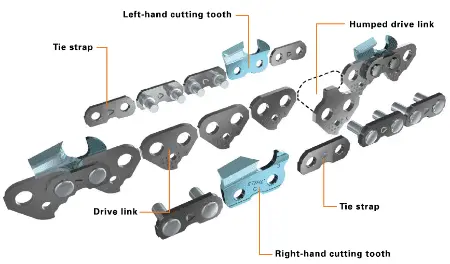
Unless someone is a professional and has experience with handling a chain saw, it is very easy to be confused about the different types of chainsaw chains.
Have you realized that your chain is dull and not cutting properly? In case you already tried or simply do not want to be messing around with sharpening, just buy yourself a new chain.
But what to look for when buying a new chain? Of course, it should have a size that fits the bar of your chainsaw, but there are other considerations as well.
Typical chain specifications are:
- Gauge: the thickness of the drive links, dictated by the gauge of the bar. Usual gauges range between 0.050-inch to 0.063-inch.
- Pitch: the average distance between two rivets. Typical pitches are 0.325″, 0.375″ and 0.404″.
- Length: is described by the number of drive links. This number is determined by the length and type of bar, the sprocket size, and the overall configuration of the saw. For replacement purposes, simply count the drive links on the old chain (source).
If you are less experienced with chainsaws then go for a low-profile chain with low teeth and safety elements between the teeth. These chains are more tolerant against dirt and have a lower risk for kick-back.
Click here for chainsaw chains with a huge selection of various brands and sizes.
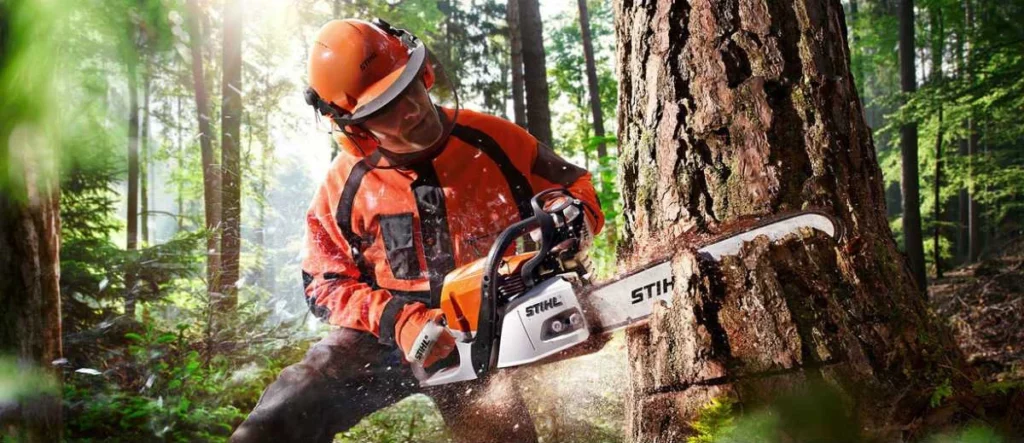
Safety and Protection
We have already discussed safety in general earlier in our 5 Minute Quick Guide: Finding the right chainsaw.
There are three major areas of safety where you can improve and therefore reduce the risk of injury.
Experience
Everyone started as a newbie but the most important takeaway here is to always be aware of your own experience level. Never ever try to buy or show off with a professional chainsaw if you never got training earlier. Leave it for the professionals and get an easy to use, homeowner chainsaw.
Responsible habits and safety procedures
You have to adapt proper and responsible habits when working with a chainsaw. These habits should include actions to wear safety gear, carry out inspection of the saw before using it (use a checklist!), follow maintenance schedules, and keep close a first aid kit.
Protective gear
Protective and safety gear is absolutely necessary for using the most powerful tools, and it is even more valid for chainsaws. Specialized safety gear exists for chainsaws such as leg protections (chaps or pants), hard hats, gloves, and so on.
It is inevitable that you will get in contact with the chain or flying debris at some point so better be prepared than sorry.
Chainsaw protective clothing
In order to ensure optimum protection, you should always following best practices and recommendations regarding what to wear whenever you are working with a chainsaw. There is a general consensus worldwide on what clothing is suitable, but local jurisdictions can have specific rules so better check these out.
Clothing in general
Clothes worn should fit well and shouldn’t dangle or have ragged edges that could get caught on bark, limbs, or the saw.
Hard hat or helmet
Ensure to wear a properly fitted hard hat that’s comfortable and gives protection from small falling debris or limbs. A helmet also offers some protection against impact by the cutter bar in case a kick back occurs.
Chainsaw helmets often come with eye protection guards or visors, protecting eyes and the face from flying wooden bits and debris.
Helmets have a recommended lifetime and should be replaced every 3 to 5 years.
You can find a good range of chainsaw helmets on Amazon.
Eye and Face protection
Always wear either a full-face shield or safety glasses or safety goggles with side shields to shield your face from flying twigs, sawdust, and wood chips. As discussed, most helmets have visors and face protectors but still, consider using glasses or goggles in addition.
Chainsaw chaps or pants
Chainsaw trousers do save lives. If you think this safety gear is overkill, then think again. They will not stop a running chainsaw on full power but will offer a chance to save your leg in those crucial few seconds when it first touches your trousers.
Read more: The Best Chainsaw Chaps Review
There are two major types of chainsaw trousers:
- Type C covers the whole leg offering protection on the back side and is generally worn as ordinary trousers
- Type A trousers only protect the front of the legs and are generally referred to as chaps. Can be worn over ordinary work trousers or on their own. These types of trousers are recommended for homeowners and for general use as they provide adequate protection combined with comfort and cost-effectiveness.
Budget chainsaw chaps only protect from flying debris, while more expensive and professional ones have extra reinforcements like kevlar or layers of ballistic nylon to protect against chain injuries.
Hearing protection or ear defenders
Gas powered chainsaws are immensely loud, way above the recommended noise exposure limit of 85 dB. Always wear ear defenders or earplugs as well as ear covers to protect your ears from the level of noises related to operating a chainsaw.
Utilize hearing protection that has a minimum noise reduction rating of 25 to lessen your risk of having noise-induced hearing loss.
We kindly recommend the outstanding all-in-one Husqvarna ProForest Chain Saw Helmet System with excellent reviews. It comes with a UV-protected hard hat, 25 dB (A) NRR hearing protectors, a face screen, and a rain neck protector.
Gloves
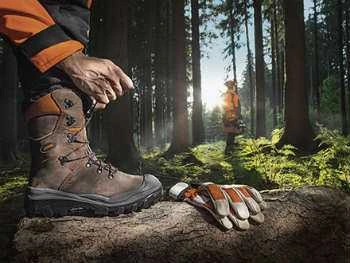
You should wear gloves made from leather in order to protect your hands from abrasions, splinters, or cuts.
You may likewise wear gloves specially made for woodcutters or for homeowners with regular chainsawing needs. They have slip-resistant palms and are also made of cut-resistant material like the material in chaps.
We recommend the Husqvarna 579380210 Functional Saw Protection Gloves and these Youngstown Kevlar Gloves.
Boots
Make sure to always wear steel-toed high-top boots having aggressive-threaded soles just to protect your feet from likely contact with the saw chain and also protect you from slipping at any point during the operation.
Conclusion
Hope you have found our chainsaw buying guide helpful. Thanks for your time and feel free to check out our related posts.
